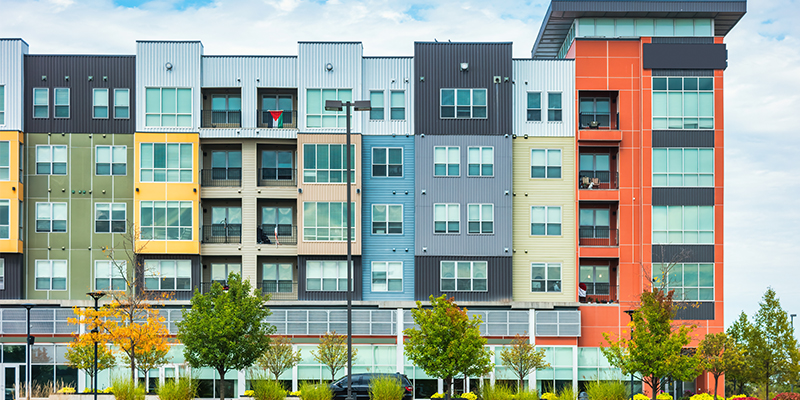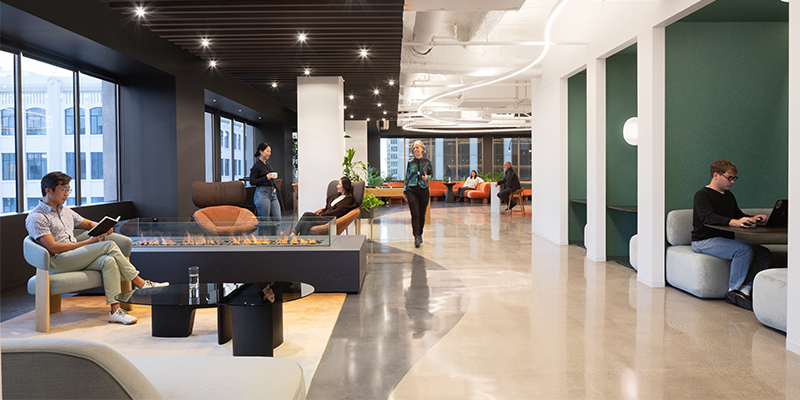Converting existing buildings to new uses is a growing trend in commercial real estate. A session during NAIOP’s CRE.Converge 2022 in Chicago this week profiled three projects that provide valuable insights into successful conversions.
The Curtis, Philadelphia
In 2014, Keystone Development acquired The Curtis, an iconic 12-story office building in Philadelphia, with the goal of converting it into a mixed-use destination. Built in 1910, the historic Beaux Arts building was the headquarters of the Curtis Publishing Company, which published and printed the Saturday Evening Post, Ladies Home Journal and many other periodicals within the one-million-square-foot building. A 12-story atrium and the “Dream Garden” mural, designed in 1916 by Louis C. Tiffany using hand-blown glass, are the building’s signature design features, along with views of Independence Mall and Washington Square Park.
Keystone took the eastern side of the building and converted it into luxury apartments.
“Obviously, it’s a 100-year-old building, so there were a lot of challenges,” said Jennifer Rosenberg, development director with Keystone Development.
In addition to a lack of original drawings (the only schematics came from the building’s conversion to an office in the 1980s), Rosenberg said there were lots of unforeseen obstacles. For example, the building’s deep floorplates posed a significant design challenge.
“We were forced to create numerous layouts with 13-foot ceilings throughout the property,” Rosenberg said. “We created units that were much larger than typical apartments, with floor plans that range from 600 square feet to 2,000 square feet.”
Rosenberg said the conversion took three years to complete.
“Every time we opened a wall, there was a different surprise,” she said.
According to Rosenberg, the most challenging was the “asbestos, asbestos, asbestos.” Abating the fire-retarding material, which is a known carcinogen, involved tenting the entire building while workers toiled in hazmat suits.
Tesla Dealership and Service Center, Silver Spring, Maryland
Next, Rob Marek, principal with E-Z Riser Roof Raising, described a project to raise a roof on a 28,000-square-foot suburban office building in Silver Spring, Maryland, that was recently converted into a Tesla dealership and service center. Built in 1995, it was originally an automobile insurance office and car inspection facility.
“What I think is remarkable about this project is how unremarkable it is,” Marek said. “It was formica and cubicles from wall to wall.”
Tesla’s ask was simple – raise the roof two feet: from 12 feet, six inches, to 14 feet, six inches.
“There was no real construction on the building at all,” Marek said. “This was lightning fast.”
Structural work involved reworking the façade, adding new foundations for car lifts and minor layout changes for service doors. Marek said the overall renovation cost was $2.5 million, but only about $600,000 to $700,000 was shell work. Raising the roof only cost around $300,000. Overall, he said it was faster to raise the roof than to demolish and rebuild, especially amid COVID-19-related supply chain issues.
“It was not a remarkable job, but if you hit a lot of doubles, you can score a lot of runs,” Marek said.
Allstate Campus Conversion, Northbrook, Illinois
Finally, Tim Walsh, chief investment officer with Dermody Properties, discussed his firm’s planned conversion of the huge Allstate Insurance campus in suburban Chicago into a 10-building logistics site spanning more than 3.2 million square feet.
The Allstate campus first opened in 1967. It featured three large office buildings on 232 acres. The insurance giant once had 13,000 employees at the campus, but that number dwindled to around 8,000 prior to COVID-19. According to a November 2021 article in The Real Deal, the pandemic led more than 95% of Allstate’s workers to go remote, so the company looked to sell the property. Dermody purchased it for $232 million, eyeing its proximity to major highways and O’Hare International Airport. However, the company had to spend a year in negotiations with local authorities over a variety of issues. Walsh said approvals should be finalized in the next few days and construction could start soon, but it wasn’t an easy journey.
“The project went through lengthy public process,” he said. “We had seven different public hearings, and all kinds of traffic and noise studies. Hundreds of people showed up to talk about it, because you’re replacing a longstanding corporate neighbor with tractor-trailers.”
Walsh said Dermody will preserve 50 years of plant life and growth on the site by relocating thousands of trees to camouflage the industrial buildings. Truck noise will be contained to the middle of the site. Because the 10 buildings will range in size from 92,000 square feet to 455,000 square feet, Dermody aims to attract all kinds of users that won’t depend on large trucks, including showrooms and even data centers – the latter a legacy from Allstate’s extensive investments in fiber optics and electrical connections at the site.
According to Walsh, Dermody will spend very little on roads and infrastructure, and future plans including putting solar panels on every roof.
“This is a really exciting project to bring to market,” he said.
Walsh said the best advice he could give other companies looking to do similar projects is to build partnerships with local municipalities.
“If the town didn’t want it here, it wouldn’t be going here,” he said. “If they weren’t a partner, we’d be dead on arrival.”

This post is brought to you by JLL, the social media and conference blog sponsor of NAIOP’s CRE.Converge 2022. Learn more about JLL at www.us.jll.com or www.jll.ca.








